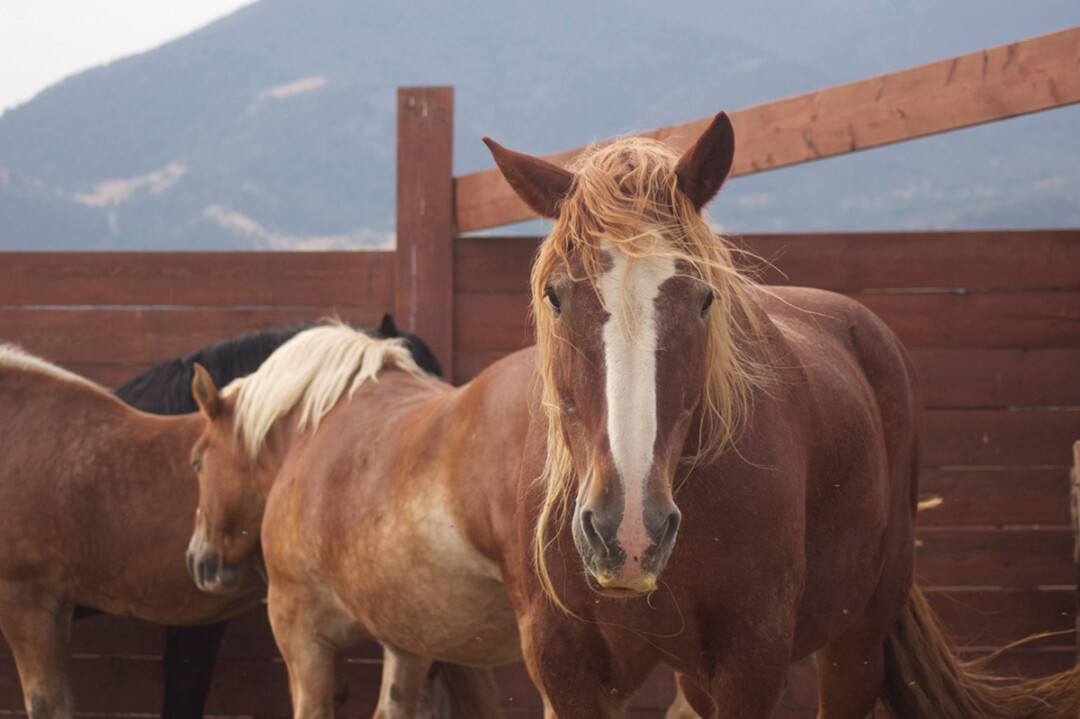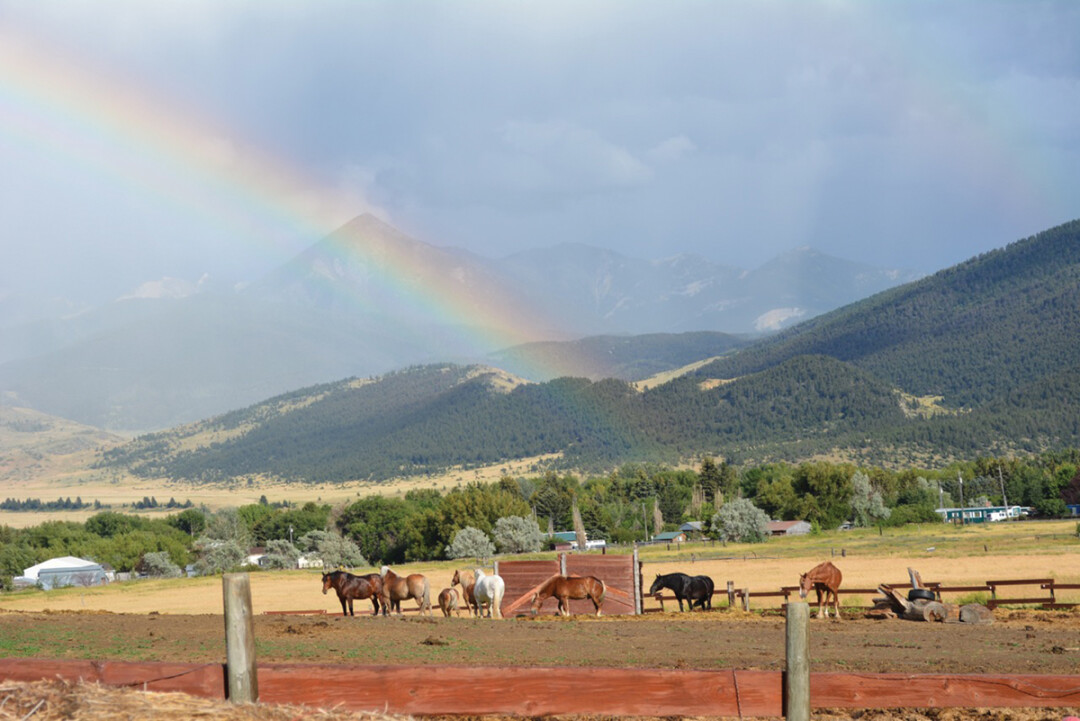United in Light: A Mission of Love
When I visited United in Light’s Draft Horse Rescue sanctuary, It was a windy Saturday afternoon, presaging winter with its chill. Nestled in a small valley in Livingston with a view of the distant snow-tipped Absarokas, the ten-acre sanctuary receives the brunt of mountain winds, fortunate for keeping flies away from the horses and drying out the pasture. As Deborah Derr, the founder of United in Light, and I stepped through the mounds of manure, holding our hats and pushing flyaways from our eyes, the draft horses gathered around one hay dispenser lifted their heads and snorted.

“Look at them,” Deborah said with a smile. “They’re our gentle giants.”
Gentle giants with horrific pasts: all of the draft horses at United in Light have suffered some severe form of abuse or injury at their former locations, often rural farms in various parts of the nation. As Deborah and I smoothed and kissed the warm flanks and noses of the horses around the hay dispenser, Deborah told me about Furrow, the sienna-colored Suffolk Punch to my left. When Deborah rescued Furrow, 26, from St. Ignatius, she could place an index finger between his ribs. When she tried to untangle his mane, it came apart in handfuls, an indication of malnutrition and organ deterioration.
“These horses are frequently treated as nothing more than livestock or equipment,” Deborah said. “Their livelihood is rigorous. They are worked into the ground from the moment they are able, and many literally stop dead in their tracks.”
Deborah grew up in Illinois, a state with extensive Amish country, and therefore has been familiar with the types of conditions draft horses may face on such farms for quite some time. Deborah explained that most draft horses, worked under these conditions, only live into their teens.
“Many people assume that because these horses are so big, they won’t reach twenty,” Deborah explained. “But draft horses are not like dogs. Our horses here live well into their thirties.”
United in Light is one of the only 501c3 non-profit organizations devoted to rehabilitation of elder abused draft horses in the United States. It has been operating for thirteen years, since Deborah initiated it in 2003 in northern Arizona. She relocated to United in Light’s present location in 2007. Since its inception, United in Light has assisted twenty-nine draft horses and found homes for hundreds of others. The organization is fully publicly-funded and supported by over eighty regular volunteers, several of whom were working in the pasture when I visited, helping to stain fences and build an observation deck for wheelchair access. We could hear laughter from the fenceline.
“I have many mutual friends who run their own sanctuaries,” Deborah told me. “They do so fiercely and aggressively. But I don’t like that. I want this to be a place of fun and laughter, of joy. And it is.”
We made our way over to the fenceline and the working volunteers, stepping over rinds of melons and oranges, remnants of the expired fruit donated by Bozeman’s Costco warehouse. As most of United in Light’s boarders suffer from metabolism diseases, they follow a diet low in sugar and high in protein, and have constant access to grass hay.
Karen Renbarger, one of the volunteers and a board member of United in Light, paused to wipe the stain that had managed to speckle her face. Her eyes were bright as she described her experience at United in Light. “I have been volunteering here for nearly five years,” she said. “And these people have become my family. But most of all it is amazing to work with these horses. They show such strength and spirit to overcome their pasts. We become very attached to them. It’s nearly impossible to bear the grief when they die.”

When one of United in Light’s horses does cross over, as Deborah describes it, the organization invites the public to share in the experience of celebrating and mourning the animal’s life. United in Light holds a public ceremony following the horse’s crossing, primarily to demonstrate that death does not have to be traumatic.
“We learn to love and to grieve,” Deborah said.
This, however, is not all that the sanctuary can teach. Karen and Deborah both agreed that the horses invariably instruct visitors to inhabit the present moment. Karen recalled one horse that would turn his back to her every time she approached until she was ready to be fully committed to emotional attentiveness.
“The horses are a mirror,” she said. “They bring all of your fears and insecurities to the surface. They are so much more aware than we humans think they are.”
United in Light has proven to be a sanctuary not only for its boarders. Individuals struggling with mental illness, depression, and trauma have found healing within its fences, discovering peace and a sense of foundation amidst the draft horses overcoming their own scars, often in profound ways.
“These horses are forgiving and gentle to humans, despite their abuse,” Deborah affirmed. “Despite all of the trauma, they are still willing to open up to love.”
The boarders at United in Light compose a herd, which welcomes newcomers almost ritualistically. The horses are curious about a new member, and perform what Deborah describes as a dance, meeting with crowns touching in a circle. The organization also invites the public to such welcomings.
One of the horses had followed us to the fence: Sundance, nearly nineteen hands tall, the brother of Squire, nicknamed “Curious George.” He butted his nose against us as Deborah described other futures most draft horses face, one of which Sundance and Squire escaped by literal minutes: slaughter after being purchased at auction by a “killer-buyer,” a representative who attends such auctions to purchase horses for fattening and eventual selling to slaughterhouses in Canada and Mexico. The inevitable expense of sustaining a draft horse, particularly one with behavioral and physiological issues, is a reason why many draft horses are ushered to auction. A boarder costs United in Light approximately six to eight thousand dollars annually.
An equally dire fate are premarin farms that harvest the urine of pregnant draft mares to be used in hormone treatment therapy for menopausal women. These mares are confined in narrow stalls and impregnated. Their urine is collected and the foals are either aborted or sent immediately to auction upon birth.
United in Light is home to one such mare, who arrived pregnant at the sanctuary. She paced fretfully along the fence until Deborah consoled her, recognizing the mare’s anxiety at the possibility of her foal being taken away as all her others had been. The foal the mare gave birth to, Promise, unfortunately passed away at age five from a heart attack. A bronze statue of a winged horse, placed just beside the gates to the pasture, commemorates Promise as well as United in Light’s first boarder, Knight of Dreams.
“We do not make the horses accommodate to us,” Deborah said. “We accommodate to them.”
United in Light currently provides sanctuary to nine draft horses and one quarter horse. Its capacity is ten to eleven members. Deborah hopes to expand United in Light, potentially making use of twenty-two empty acres in front of the pasture to provide indoor and outdoor arenas for the horses. Right now, United in Light focuses particularly on education outreach.
“People leave here smiling,” Deborah said. “It is my hope that this organization will last for generations and generations.”
Prospective volunteers and visitors can peruse United in Light’s website (http://www.draftrescue.com) for further information. Visiting hours are 10 AM - noon on the first Saturday of every month.
